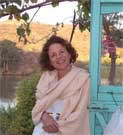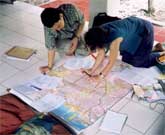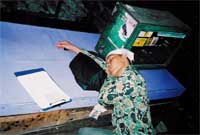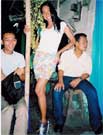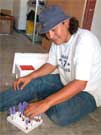This is the old Ternyata site, maintained for archival purposes. You can see the new site at http://www.ternyata.org
Currents
: Indonesia was once relatively free of hard drugs; But over the past decade, heroin use has mushroomed; Government and society are ill-equipped to cope
By John McBeth in Jakarta
1594 words
19 August 2004
50
English
(c) 2004 Dow Jones & Company, Inc.
AT 27, Rodiyah Sahuddin doesn't have long to live. Diagnosed HIV-positive and racked by hepatitis C and tuberculosis, Rodiyah -- who has a seven-year-old daughter -- sits pop-eyed and emaciated on her Jakarta hospital bed. Beads of sweat glisten on her forehead as she talks in short gasps about how she began experimenting with heroin eight years go. The drug has now destroyed her life.
Rodiyah's eldest brother, also a heroin addict, died three years ago of Aids. Her youngest brother, aged 22, is a junkie as well. Gnarled hands clasped in front of her, Rodiyah's 62-year-old mother, Rumsiah, leans on her only daughter's bed and struggles to explain her emotions. "I feel shame, I feel angry," she murmurs softly, "but what can I do? They're my children and I have to take care of them."
It has taken a rising toll from HIV-Aids for Indonesia to wake up to an uncomfortable fact: Heroin addiction, often involving a deadly cocktail of shared needles and unprotected sex, is making deep inroads in a country that was once relatively free of drugs. In less than a decade, the population of heroin users has mushroomed from just a few thousand to nearly 200,000.
Last year, Indonesian police seized 21.8 kilograms of heroin, up from 14 kilos in 1999, and brought charges against 3,900 dealers -- nearly 2,000 more than in 2002 and four times the number five years ago. On August 5, a firing squad executed a 67-year-old Indian trafficker -- the first to die for a drug-related offence in Indonesia. There are 33 other convicted traffickers on death row, many of them foreigners. But despite the seizures and arrests, detectives admit they have no real idea of how much heroin is entering the archipelago.
By regional standards, Indonesia's narcotics trade appears relatively modest. For instance, Thai police last year seized 450 kilograms of heroin and arrested 89,700 people on drug-related charges (although those figures were boosted by the government's anti-drug campaign). And while non-governmental organizations and other sources familiar with the trade estimate that Indonesia has twice as many addicts as Thailand, the archipelago's population is almost four times larger.
Still, what is striking in Indonesia is how rapidly the problem has grown, particularly over the past decade, as heroin has moved off university campuses and into poor urban neighbourhoods. "Ten years ago it was almost non-existent," says Elizabeth Pisani, who tracks HIV infections for Family Health International, a United States-funded NGO. "It came out of nowhere and it was supply driven." Even government officials have been taken aback by the hidden scale of addiction: "We were very surprised when we discovered how serious the heroin problem is," admits Maj.-Gen. Togar Sianipar, chairman of the National Narcotics Board, which was formed just two years ago.
Irwanto, a psychiatrist and the head of the Atma Jaya University Research Institute, runs Kios Atma Jaya, an outreach programme for addicts which is funded by the U.S. Agency for International Development. He says that while heroin has been around since the 1970s, it became freely available only in the dying days of President Suharto's regime in the mid-1990s.
Views differ on the reasons for that. Irwanto and other health workers say powerful elements in the police and the military protect and even encourage the trade, adding to a growing list of illegal businesses they have reverted to since the collapse of the country's economy in 1997-98.
Competition between the two forces is intense. When the police were separated from the military chain of command in 2000, the two became embroiled in a struggle for control of the drug trade. The real extent of that conflict broke into the open in November 2002, when eight people were killed in a drug-related gun-battle between the police and the military in North Sumatra. Former Defence Minister Juwono Sudarsono acknowledged then that drug-smuggling had become part of the military's illicit activities.
Police put the current street price for heroin in Jakarta at 500,000 rupiah ($52) a gram, or 50,000 rupiah for a single 0.01 gram hit of 50% pure heroin. According to narcotics officials, those prices are about two or three times higher than in Bangkok, where a 700-gram "unit" of 100% pure heroin wholesales for $8,750 and the proximity of the Golden Triangle makes smuggling less risky.
Interviews with drug users in Jakarta confirm that the high price means many addicts can afford their habit only by becoming "jockeys" -- members of the distribution chain. Ruly, 30, is one of them. "I've never had a job," he says, clutching a bag of pills he hopes will stop the aching in his bones. "All I've been is a jockey." Like Rodiyah, Ruly lives in Kampung Bali, a square block of narrow lanes in the crime-ridden Tanah Abang section of central Jakarta. There, 92% of the 200 addicts tested by the Pelita Ulna Foundation so far have been diagnosed with HIV.
Ruly learned he had the disease two years ago. "With God's will I will live to 40," he says. "The doctor told me to pray more." He and almost every other addict tell the same story. Some started with cannabis or amphetamines, others began smoking heroin out of curiosity. For the first couple of weeks -- time enough to get hooked -- it was provided free. It wasn't long before they were injecting the drug to get better value for money.
In a small back-street in Cideng, a few kilometres northwest of Kampung Bali, about 20 addicts gather for a counselling session with Kios Atma Jaya workers. Magdelena, 25, one of three women in the group, recalls starting to use heroin when she was just 14. Ocoy, 30, took it up in his early 20s. Ask how many share needles, the easiest way to transfer HIV, and more than half the group raise their hands. Magdelena, cute in her red T-shirt and reversed white baseball cap, is among them. Here, about 74% of addicts are HIV-infected.
The source of Indonesia's heroin supply has changed in recent years. Narcotics agents say far less pure-grade Golden Triangle heroin is now coming into the country, in particular since Thai Prime Minister Thaksin Shinawatra unleashed a major crackdown early last year, which led to the deaths of an estimated 2,500 small-time drug dealers. Most of Indonesia's heroin now comes from Afghanistan and Pakistan, a flow that first began -- largely unnoticed -- in the late 1990s.
Southeast Asian heroin is mostly the domain of ethnic-Chinese trafficking syndicates, but in Pakistan American narcotics officials describe a "hybrid" network of West African and Pakistani traffickers, using mainly African, Nepalese, Thai and Indonesian couriers. In some cases, African dealers have used their own Indonesian wives to carry the drug. "I think it's growing and growing," says one Asia-based United States Drug Enforcement Administration agent. "There's an awful lot of it in transit to Australia and the U.S., but a lot of it also stays in Indonesia."
How much is anyone's guess in a country that lacks even basic data on the drug trade. Health workers reckon police seize only 0.5% of the heroin entering the country each year. Wayne Wiebel, a pony-tailed, Harley-riding epidemiologist who is seeking to replicate in Jakarta an HIV-intervention project among needle users that he pioneered in Chicago, believes the fact that most heroin is sold in Indonesia at 50% purity indicates a plentiful supply: "By world standards, that's kick-ass. In some places it is only 2% to 3%." Still, Wiebel believes that, despite the abundant supply, heroin use may have reached its peak as people begin to understand the harm it does.
Most drug busts are made at Jakarta's Sukarno-Hatta International Airport, but with 142 ports and airports and countless thousands of unguarded entry points around the archipelago, Indonesia is wide open. Adang Rochjana, deputy director of the Criminal Investigation Board's drug-law enforcement and organized-crime directorate, says the last sea-borne heroin seizure was made in 1994 when a 28-kilogram shipment was intercepted after being smuggled into Sumatra from Port Klang in Malaysia.
Irwanto believes Indonesian heroin shipments these days are being moved by African gangs, many of them posing as buyers at Jakarta's Tanah Abang textile market. They almost certainly have high-level Indonesian connections, the same businessmen and underworld figures who control gambling and prostitution and supply locally made amphetamines and Ecstasy to a growing population of upper-class thrill-seekers. "They're doing all this under our noses," says Irwanto.
Indonesia has about 1,300 anti-narcotics policemen, but there are now more pressing priorities. Because of their experience and dedication, many of Indonesia's small core of top narcotics agents spearheaded the investigations into the Bali and J.W. Marriott Hotel bombings. Funded by the U.S. and other Western countries, they are now working full time on the continuing hunt for key members of the Jemaah Islamiah terrorist network.
Meanwhile, the heroin keeps flowing.
|
